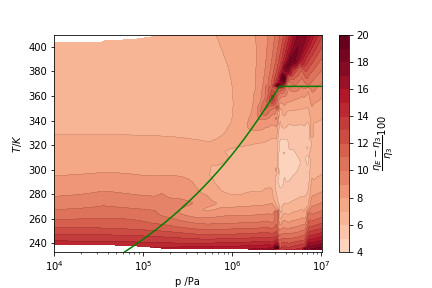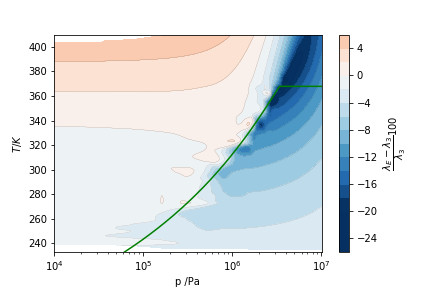R1234yfにおける冷媒物性の改善

Modelon’s Air Conditioning Library and Vapor Cycle Library now include upgrades to the transport properties of the fluid R1234yf. R1234yf has now migrated to being built upon a three-component model from an ECS (extended corresponding states) model.
In this blog, we detail the modeling benefits of this upgrade and explain how to ensure your existing models, using R1234yf, remain intact.
Background on modeling fluid transport properties
In the context of thermofluid systems, fluid properties such as pressure, density, enthalpy, heat capacity, compressibility or speed of sound are calculated from an equation of state. Conversely, the transport properties such as viscosity, thermal conductivity, and surface tension are calculated from dedicated correlations. Of these, both viscosity and thermal conductivity are split into contributions (shown below). The dilute (or zero density) contribution can be treated by kinetic gas theory, which is usually modeled by simple polynomials. However, the critical enhancement of viscosity can only be seen in a very small region and in the published literature it is neglected for all fluids except CO2 and water. For thermal conductivity, the critical enhancement is significant in a wider region and is usually modeled based on the model by Olchowy and Sengers. This model is dependent on the equation of state and the viscosity correlation; thus, it can only be employed if reliable models exist for these properties. As dilute and critical contribution rely on theory, little experimental data is required for the fitting.

If only very little experimental data is available, the background contribution can instead be modeled using extended corresponding states (ECS) theory. The basic idea of ECS is that: one fluid, R1234yf, at one state behaves like a reference fluid, R134a, at a different state (the so-called conformal state). The algorithms for finding the conformal state are quite complex and involve non-linear iterations that are hard to converge in some regions.
The advantage of the ECS model is that little experimental data is required to develop it, resulting in early publications using ECS for modeling the transport properties. However, the disadvantages of the ECS model are that it often can be used for a limited range and the algorithms are an additional source for potential numerical difficulties.
Migration to three-component model for R1234yf
With the 2018.2 release of Modelon libraries, the three-component model for the transport properties viscosity and thermal conductivity for R1234yf has been added to Modelon’s Air Conditioning Library and Vapor Cycle Library.
To understand the impact of switching to the new transport property model, a comparison plot is given below. Plotted is the relative percentage deviation between the two models over the p,T plane. Positive values indicate the value from ECS model is higher than from the three-component model. The green line is the saturation line, for orientation, low p is the vapor region, high p is the liquid region.


The deviation is up to 25%, with typical values much lower in the region of interest for many applications. The highest deviation is seen at the continuation of the saturation line, that is at values close to the critical density. Within one region, the error is a systematic error, so the impact on system simulation and key results is expected to be lower.
The code for recreating the plots is available upon request.
What do these changes mean for my existing models using R1234yf?
For new simulations, the three-component model is recommended, but the ECS model is still available, in a sub-package named “Deprecated”. When trying to reproduce previous simulations, or when using calibrated models, the R1234yf medium with ECS from the deprecated package should give identical results as before. As there is no automatic conversion to the now deprecated model, one must get active to use it. The ECS model is still fully supported, tested and receives fixes, for example, it received many fixes to improve stability for the ECS iterations.
References:
Olchowy and Sengers https://doi.org/10.1007/BF01133538
Bell and Lemmon https://doi.org/10.1016/B978-0-08-100510-1.00004-1
https://github.com/usnistgov/REFPROP-issues/issues/158#issuecomment-485277203


